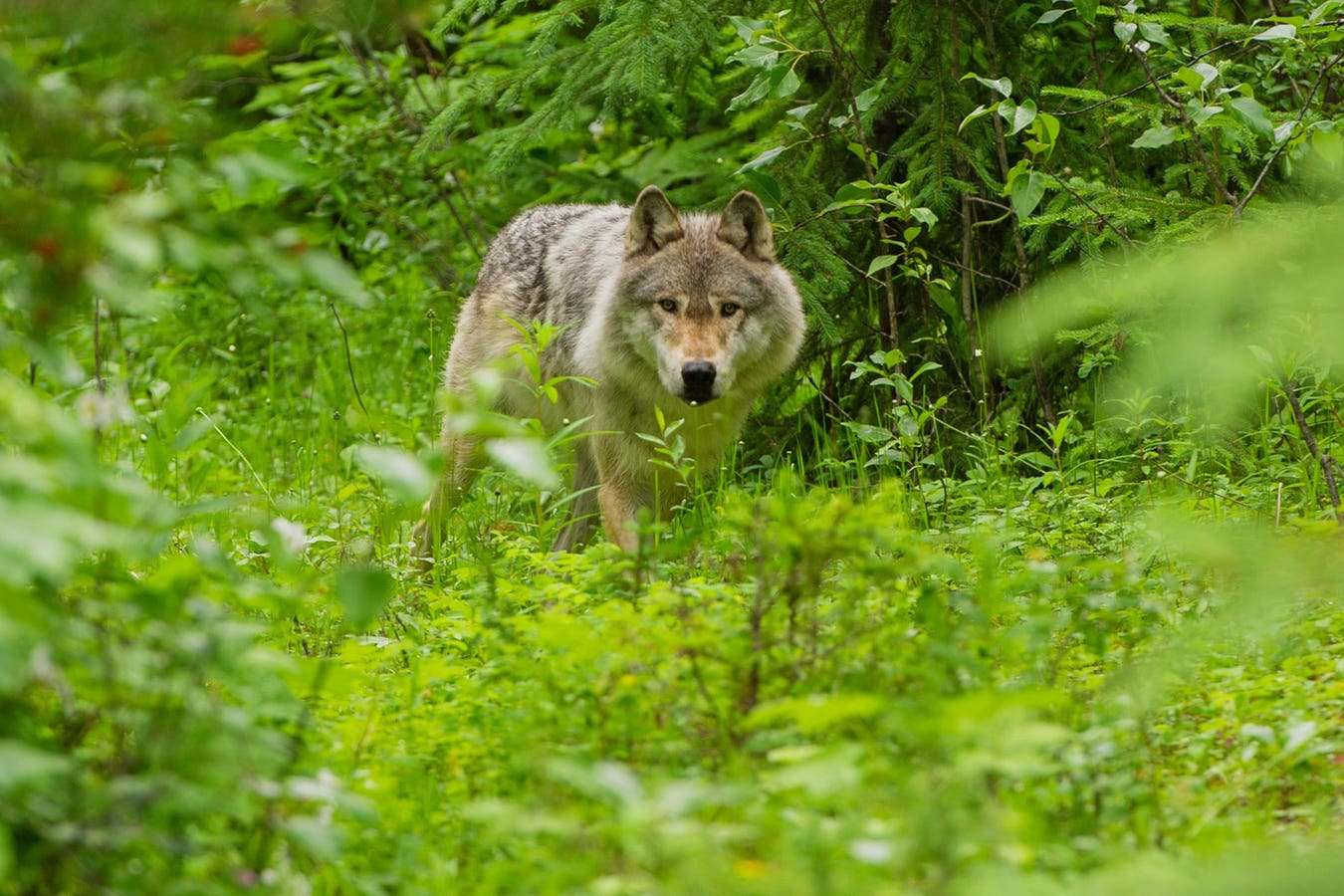Colorado’s gray wolf who traveled over 1,000 miles was from British Columbia like this one.
A Canadian gray wolf walked 1,230 miles sightseeing in her new Colorado home from January through mid-April since moving there at the start of this year in the state’s wolf restoration program.
Calling this long stroll “an extraordinary display of the species’ natural roaming behavior,” Colorado Parks and Wildlife issued this finding April 24 in its “Monthly Collared Gray Wolf Activity Map.”
The female gray wolf was among 15 who were translocated from the central interior of British Columbia to Colorado in mid-January.
“Wolves can and do travel long distances,” Brenna Cassidy, CPW wolf monitoring and data coordinator, noted in the public announcement.
The CPW issues monthly maps to let the public know where the gray wolves have been. The animals are released and monitored using satellite GPS collars to show state biologists about survival and where the wolves are roaming.
“As the population of wolves increases in Colorado, the likelihood of pairing, breeding, and pack formation increases. Our goal is to maintain at least two active collars per pack, so this current phase of wolf restoration is unique in that the majority of the wolf population is collared,” CPW stated.
A refuge manager fastens a tracking collar around the neck of a gray wolf.
The tracking maps use watersheds that drain into specific bodies of water to show gray wolf movements in geographic habitats instead of the boundaries of cities and towns. A highlighted watershed on a wolf tracking map only indicates the animal was in some part of that specific watershed during a given monthly metric.
“This single wolf’s movement traveled nearly the entire southern line of watersheds on our map,” Cassidy explained. “It simply shows that a GPS-collared wolf moved through a watershed that encompasses areas of wilderness and the city, often very quickly.”
The wolf activity maps give agricultural producers a general idea about the location of gray wolf activity without specific detains to protect individual wolf movements.
“As wolves continue to explore Colorado, CPW reminds the public that these movements were expected and are a natural part of the reintroduction process,” CPW stated. “Wolves are habitat generalists, meaning they can thrive in many environments as long as prey is present. Over time, wolves will continue to disperse across the state to establish territories.”
Monthly Collared Gray Wolf Activity: March 25, 2025-April 22, 2025.
A look at the map shows a large area where wolves have been in just one month. CPW stated that recent tracking indicates the gray wolves were roaming in watersheds west of Denver, Boulder and Estes Park.
“While these areas lit up due to brief movement on the western fringes of these watersheds, it does not mean that wolves were or are currently in high human-density areas,” CPW clarified. “Wolves continue to make broad movements across many western counties. Wolves travel long distances to find food, mates and space to live.”
The state shares information about how to spot gray wolves, where to report sightings and information.
“Gray wolves are habitat generalists. If you liveor recreate in the foothills or mountains of Colorado, you are in wolf country,” CPW warns.
The state has been working to reintroduce and manage gray wolves west of the Continental Divide.
“We want to remind everyone that you may not have wolves on your property, but you likely already live among mountain lions and black bears,” said Cassidy. “The same precautions that help prevent conflicts with those animals — like securing attractants and watching pets — are just as effective with wolves.”
Colorado has agreements with neighboring Arizona, New Mexico and Utah that if one of its wolves crosses the state boundary, that wolf will be repatriated to Colorado.
The gray wolf in Colorado is protected under state law and also listed as a federal Endangered Species Act. Two gray wolves from British Columbia were reported dead in April. CPW received a mortality alert for a female Canadian gray wolf on April 20 in the Rocky Mountain National Park. No further details were provided due to an ongoing investigation. On April 9, another gray wolf mortality was reported. The male wolf also had been released into Colorado from British Columbia but was found in Wyoming. Noting that the wolves can travel from Colorado to other states seeking food and mates, CPW was working with counterparts in Wyoming to return the tracking collar.
The average lifespan is three to four years for a gray wolf in the Rocky Mountains.
The state plans to release from 10 to 15 gray wolves annually over a period of three to five years into locations west of the Continental Divide. The animals are thought to disperse east of the divide.
To increase the changes that the gray wolves remain in Colorado, the animals will not be released within 60 miles of neighboring states.








